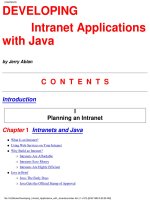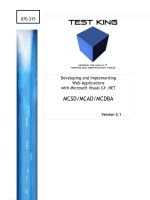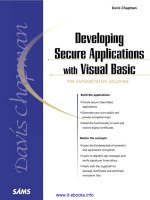DEVELOPING Intranet Applications with Java
Bạn đang xem bản rút gọn của tài liệu. Xem và tải ngay bản đầy đủ của tài liệu tại đây (1.41 MB, 398 trang )
DEVELOPING
Intranet Applications
with Java
by Jerry Ablan
C O N T E N T S
Introduction
I
Planning an Intranet
Chapter 1 Intranets and Java
What Is an Intranet?
●
Using Web Services on Your Intranet
●
Why Build an Intranet?
Intranets Are Affordable
❍
Intranets Save Money
❍
Intranets Are Highly Efficient
❍
●
Java in Brief
Java: The Early Days
❍
Java Gets the Official Stamp of Approval
❍
●
CONTENTS
file:///H|/Books/Developing_Intranet_Applications_with_Java/docs/index.htm (1 of 23) [8/30/1999 3:55:06 AM]
Java in Action
❍
Rapid Development with Java
❍
Using Java on an Intranet
Using a Java Application to Track Employee Files
❍
Using a Java Application to Schedule Appointments, Meetings, and Conferences
❍
Using a Java Application to Track Who Is in the Office
❍
●
Summary
●
Chapter 2 Designing Intranet Applications with Java
Intranet Programming with Java
Applets versus Applications
❍
Conceptualization and Design of Intranet Applications
❍
●
Creating Applets
The Benefits and Drawbacks of Applets
❍
Browsers for Your Applets
❍
●
Placing Applets in HTML Documents
Introduction to HTML
❍
The Java Extensions to HTML
❍
●
Creating Applications
More Options with Applications
❍
Applications Have a Different Structure
❍
Applications Have Different Security Considerations
❍
●
Running Applications and Applets
●
Summary
●
Chapter 3 Planning Your Intranet Environment
Building Blocks for Creating a Perfect Intranet
Managing Expectations
❍
Managing Perceptions
❍
Managing Strategies
❍
Managing Goals
❍
Managing Rules
❍
Managing Behavior
❍
●
CONTENTS
file:///H|/Books/Developing_Intranet_Applications_with_Java/docs/index.htm (2 of 23) [8/30/1999 3:55:06 AM]
Determining the Best Organization for Your Intranet
Learning from the Past
❍
Applying the Past to Your Intranet's Future
❍
●
Creating Content for Your Intranet
●
Intranet Development Tools
Implementing TCP/IP Networking
❍
Creating Web Services with HTTP
❍
●
Intranet Developer's Resource Tools
HTML Development Tools
❍
●
Mapping Your Intranet in Four Easy Steps
Step 1: Determining Requirements
❍
Step 2: Planning
❍
Step 3: Design
❍
Step 4: Implementation
❍
●
Summary
●
II
Development Concepts and Environments
Chapter 4 Java Development Environments
Introduction
●
Selecting an IDE
GUI Development Tools
❍
Portability of Code
❍
IDE Experience
❍
Multiple Language Development
❍
The Bottom Line
❍
●
Symantec Café
System Requirements
❍
Overview
❍
Pricing and Additional Information
❍
●
SunSoft Java WorkShop
System Requirements
❍
●
CONTENTS
file:///H|/Books/Developing_Intranet_Applications_with_Java/docs/index.htm (3 of 23) [8/30/1999 3:55:06 AM]
Overview
❍
Pricing and Additional Information
❍
SourceCraft NetCraft
System Requirements
❍
Overview
❍
Pricing and Additional Information
❍
●
Other Offerings
Borland C++ 5.0 with Java Enhancements
❍
MetroWerks CodeWarrior
❍
Java WebIDE
❍
Kalimantan
❍
Natural Intelligence Roaster
❍
Microsoft Visual J++
❍
RogueWave JFactory
❍
Cosmo Code
❍
Summary
❍
●
Chapter 5 Intranet Security
Introduction
●
Why Security?
What Are the Security Features of an Intranet?
❍
It's Your Call
❍
●
Security on Your Web Server
Controlling Access Globally and Locally
❍
Username/Password Authentication
❍
Authentication Based on Network Hostname or Address
❍
Combined Authentication
❍
●
Secure/Encrypted Transactions
Secure HTTP (S-HTTP)
❍
Secure Sockets Layer (SSL)
❍
●
The Common Gateway Interface (CGI) and Intranet Security
●
Your Intranet and the Internet
Firewalls
❍
●
CONTENTS
file:///H|/Books/Developing_Intranet_Applications_with_Java/docs/index.htm (4 of 23) [8/30/1999 3:55:06 AM]
Virtual Intranet
❍
Summary
●
Chapter 6 Database Connectivity Options
Introduction
●
Database Overview
●
Database Terminology
●
Database Locations
Local and Remote
❍
Tiering 1-2-3
❍
●
Database Access Methods
Native Drivers
❍
ODBC
❍
SQL
❍
●
Databases and Java
Access via Web Server
❍
Access via Proprietary Server
❍
Network Access
❍
Direct Access
❍
JDBC
❍
JDBC Goals
❍
JDBC Overview
❍
JDBC Vendor Support
❍
●
Summary
●
III
Extending Java for Intranets
Chapter 7 A Model Intranet Application
Introduction
●
A Quick Overview of Intranet Applications
Configuration File Processing
❍
Logging to Disk or Screen
❍
●
CONTENTS
file:///H|/Books/Developing_Intranet_Applications_with_Java/docs/index.htm (5 of 23) [8/30/1999 3:55:06 AM]
Database Connectivity
❍
Look and Feel
❍
Coding Style Notes
●
Code Layout
Parentheses and Code Blocking
❍
Using Tabs Versus Spaces
❍
Liberal Use of Spaces
❍
Multiple Lines Per Statement
❍
●
Comments
●
Code Order
●
Summary
●
Chapter 8 Utility Classes
Introduction
●
Timers
Timer Operations
❍
Callbacks
❍
Event Timers
❍
Why Have Two Timers?
❍
●
Java Extensions
Extending Java's Date Class
❍
Application Configuration Parameters
❍
●
Summary
●
Chapter 9 Logging Classes
Introduction
●
The Log
The Log Entry
❍
The Log Interface
❍
●
The Logging Classes
DiskLog
❍
ScreenLog
❍
●
A Sample Logging Program
●
CONTENTS
file:///H|/Books/Developing_Intranet_Applications_with_Java/docs/index.htm (6 of 23) [8/30/1999 3:55:06 AM]
Summary
●
Chapter 10 Database Classes
Introduction
●
JDBC in Depth
The DriverManager Class
❍
The Driver Class
❍
The Connection Class
❍
The Statement Class
❍
The ResultSet Class
❍
A JDBC Sample Program
❍
●
Making JDBC Easy to Use
The Connector Interface
❍
The SQLFactory Interface
❍
●
The Classes
The DBConnector Class
❍
OracleSequence
❍
●
Summary
●
Chapter 11 User Interface Classes
Introduction
●
3-D Effects
The Effects Interface
❍
●
The JifPanel Class
JifPanel Design
❍
Constructing a JifPanel
❍
Smoke and Mirrors
❍
Drawing 3-D Borders
❍
Tabbing Between Components
❍
●
SQL Generation
●
The JifPanel Descendants
The CalendarPanel Class
❍
The ImagePanel Class
❍
●
CONTENTS
file:///H|/Books/Developing_Intranet_Applications_with_Java/docs/index.htm (7 of 23) [8/30/1999 3:55:06 AM]
The JifLabel Class
❍
The JifTabPanel Class
❍
The StatusBar Class
❍
The JifDialog Class
The MessageBox Class
❍
The PickList Class
❍
●
Java TextComponent Extensions
Change Detection
❍
●
Summary
●
Chapter 12 Putting Them All Together
Introduction
●
Java Compilation Basics
Java Source Code Files
❍
Have You Got the Package?
❍
Making Java Packages
❍
●
Introducing the Java Intranet Framework
Packaging the JIF Classes
❍
●
Extending the Framework
Java Applets
❍
Making JIF Easy to Use
❍
●
The JifApplication Interface
●
The Jiflet Class
Instance Variables
❍
Constructors
❍
Methods
❍
Wrapping Up Jiflets
❍
●
Programming with Jiflets
The Smallest Jiflet
❍
The HelloWorld Jiflet
❍
●
Extending Jiflets for Real-World Use
DBRecord
❍
SimpleDBUI
❍
●
CONTENTS
file:///H|/Books/Developing_Intranet_Applications_with_Java/docs/index.htm (8 of 23) [8/30/1999 3:55:06 AM]
SimpleDBJiflet
❍
Summary
●
IV
Applications Developing with JIF
Chapter 13 Employee Files
Introduction
●
Application Design
●
Database Design
●
Implementation
User Interface
❍
Database Access
❍
●
Programming Considerations
●
Summary
●
Chapter 14 Human Resources: Benefits
Maintenance
Introduction
●
Application Design
●
Database Design
●
Implementation
User Interface
❍
Database Access
❍
●
Programming Considerations
●
Summary
●
Chapter 15 Conference Room Scheduling
Introduction
●
Application Design
●
Database Design
●
Implementation
●
CONTENTS
file:///H|/Books/Developing_Intranet_Applications_with_Java/docs/index.htm (9 of 23) [8/30/1999 3:55:06 AM]
Building the User Interface
❍
Interacting with the User
❍
Database Access
❍
Reading the Existing Schedule
❍
Storing Your Schedule
❍
Generating the SQL
❍
Programming Considerations
●
Summary
●
Chapter 16 Online In/Out Board
Introduction
●
Application Design
●
Database Design
●
Implementation
User Interface
❍
Database Access
❍
A Refresh Timer
❍
●
Programming Considerations
●
Summary
●
Chapter 17 Online Employee Phonebook
Introduction
●
Application Design
●
Database Design
●
Implementation
User Interface
❍
Database Access
❍
●
Programming Considerations
●
Summary
●
CONTENTS
file:///H|/Books/Developing_Intranet_Applications_with_Java/docs/index.htm (10 of 23) [8/30/1999 3:55:06 AM]
Chapter 18 News & Announcements
Introduction
●
Application Design
●
Database Design
●
Implementation
User Interface
❍
Database Access
❍
●
Programming Considerations
●
Summary
●
Chapter 19 Product Maintenance
Introduction
●
Who Would Use This Application?
Johnston, Ulysses, Norman, and Kaiser
❍
●
Application Design
Using a Pick List
❍
●
Database Design
●
Implementation
User Interface
❍
The Product Pick List
❍
Database Access
❍
●
Programming Considerations
●
Summary
●
Chapter 20 Customer Support Maintenance
Introduction
●
Application Design
●
Database Design
●
Implementation
Building the User Interface
❍
Database Access
❍
Retrieving the Product and Problem Lists
❍
●
CONTENTS
file:///H|/Books/Developing_Intranet_Applications_with_Java/docs/index.htm (11 of 23) [8/30/1999 3:55:06 AM]
Product and Problem Selection Changes
❍
Programming Considerations
●
Summary
●
Chapter 21 Extending the Java Intranet Framework
Introduction
●
jif.util
ConfigProperties
❍
FileDate
❍
●
jif.log
●
jif.sql
●
jif.awt
JifPanel
❍
JifTabPanel
❍
StatusBar
❍
Miscellaneous
❍
●
jif.jiflet
●
Extending the Applications
Benefits Maintenance
❍
Conference Room Scheduling
❍
News and Announcements
❍
●
Summary
●
appendixes
appendix A Java Resources
Sun's Java Sites
●
Java Information Collection Sites
●
Java Discussion Forums
●
Notable Individual Java Webs
●
Java Index Sites
●
Object-Oriented Information
●
Java Players and Licensees
●
CONTENTS
file:///H|/Books/Developing_Intranet_Applications_with_Java/docs/index.htm (12 of 23) [8/30/1999 3:55:06 AM]
appendix B JDK Tools Reference
JDK Tools Reference
●
javac-The Java Compiler
Synopsis
❍
Description
❍
Options
❍
Environment Variables
❍
●
java-The Java Interpreter
Synopsis
❍
Description
❍
Options
❍
●
jdb-The Java Debugger
Synopsis
❍
Description
❍
Options
❍
●
javah-C Header and Stub File Generator
Synopsis
❍
Description
❍
Options
❍
●
javap-The Java Class File Disassembler
Synopsis
❍
Description
❍
Options
❍
●
javadoc-The Java API Documentation Generator
Synopsis
❍
Description
❍
Options
❍
●
appletviewer-The Java Applet Viewer
Synopsis
❍
Description
❍
Options
❍
●
CONTENTS
file:///H|/Books/Developing_Intranet_Applications_with_Java/docs/index.htm (13 of 23) [8/30/1999 3:55:06 AM]
appendix C Java API Reference
Reserved Words
●
Comments
●
Literals
●
Variable Declaration
●
Variable Assignment
●
Operators
●
Objects
●
Arrays
●
Loops and Conditionals
●
Class Definitions
●
Method and Constructor Definitions
●
Packages, Interfaces, and Importing
●
Exceptions and Guarding
●
appendix D Java Class Reference
java.lang
Interfaces
❍
Classes
❍
●
java.util
Interfaces
❍
Classes
❍
●
java.io
Interfaces
❍
Classes
❍
●
java.net
Interfaces
❍
Classes
❍
●
java.awt
Interfaces
❍
Classes
❍
●
java.awt.image
●
CONTENTS
file:///H|/Books/Developing_Intranet_Applications_with_Java/docs/index.htm (14 of 23) [8/30/1999 3:55:06 AM]
Interfaces
❍
Classes
❍
java.awt.peer
●
java.applet
Inetrfaces
❍
●
Classes
●
appendix E Differences Between Java and C/C++
The Preprocessor
●
Pointers
●
Structures and Unions
●
Functions
●
Multiple Inheritance
●
Strings
●
The goto Statement
●
Operator Overloading
●
Automatic Coercions
●
Variable Arguments
●
Command-Line Arguments
●
appendix F Java Intranet Framework Reference
jif.awt
CalendarPanel
❍
Effects
❍
ImagePanel
❍
JifCheckbox
❍
JifDialog
❍
JifLabel
❍
JifPanel
❍
JifPanePanel
❍
JifTabPanel
❍
JifTabSelector
❍
JifTextArea
❍
●
CONTENTS
file:///H|/Books/Developing_Intranet_Applications_with_Java/docs/index.htm (15 of 23) [8/30/1999 3:55:06 AM]
JifTextField
❍
MessageBox
❍
PickList
❍
ResponseDialog
❍
SimpleDBUI
❍
StatusBar
❍
jif.jiflet
JifApplication
❍
JifMessage
❍
Jiflet
❍
SimpleDBJiflet
❍
●
jif.log
DiskLog
❍
Log
❍
ScreenLog
❍
●
jif.sql
CodeLookerUpper
❍
Connector
❍
DBConnector
❍
DBRecord
❍
MSQLConnector
❍
MSSQLServerConnector
❍
ODBcconnector
❍
OracleConnector
❍
OracleSequence
❍
SequenceGenerator
❍
SQLFactory
❍
SybaseConnector
❍
●
jif.util
CallbackTimer
❍
ConfigProperties
❍
EventTimer
❍
FileDate
❍
TimeOut
❍
●
CONTENTS
file:///H|/Books/Developing_Intranet_Applications_with_Java/docs/index.htm (16 of 23) [8/30/1999 3:55:06 AM]
appendix G What's on the CD-ROM
Windows Software
Java
❍
mSQL
❍
Servers
❍
HTML Tools
❍
Graphics, Video, and Sound Applications
❍
Explorer
❍
Utilities
❍
●
About Shareware
●
Credits
To Kathryn. A dedication haiku:
"Love is a great thing, like puddles after the rain, or a stroll with you." -Jerry
Ablan
Copyright © 1996 by Sams.net Publishing
FIRST EDITION
All rights reserved. No part of this book shall be reproduced, stored in a retrieval system, or transmitted by
any means, electronic, mechanical, photocopying, recording, or otherwise, without written permission from
the publisher. No patent liability is assumed with respect to the use of the information contained herein.
Although every precaution has been taken in the preparation of this book, the publisher and author assume
no responsibility for errors or omissions. Neither is any liability assumed for damages resulting from the
use of the information contained herein. For information, address Sams.net Publishing, 201 W. 103rd St.,
Indianapolis, IN 46290.
International Standard Book Number: 1-57521-166-1
HTML conversion by :
M/s. LeafWriters (India) Pvt. Ltd.
Website :
e-mail :
CONTENTS
file:///H|/Books/Developing_Intranet_Applications_with_Java/docs/index.htm (17 of 23) [8/30/1999 3:55:06 AM]
Trademarks
All terms mentioned in this book that are known to be trademarks or service marks have been appropriately
capitalized. Sams.net Publishing cannot attest to the accuracy of this information. Use of a term in this
book should not be regarded as affecting the validity of any trademark or service mark.
Java is a trademark of Sun Microsystems, Inc.
President, Sams Publishing Richard K. Swadley
Publishing Manager Mark Taber
Managing Editor Cindy Morrow
Director of Marketing John Pierce
Assistant Marketing Managers Kristina Perry, Rachel Wolfe
Acquisitions Editor Beverly M. Eppink Development Editor Kelly Murdock
Software Development
Specialist
Bob Correll Production Editors Mary Inderstrodt, Ryan
Rader
Copy Editors Brice Gosnell, Stacey Houston,Kristen Ivanetich, Howard Jones
Indexer Johnna VanHoose Technical Reviewers Will Kelly, Billy Vernon
Editorial Coordinator Bill Whitmer Technical Edit
Coordinator
Lorraine Schaffer
Resource Coordinator Deborah Frisby Editorial Assistants Carol Ackerman, Andi
Richter, Rhonda
Tinch-Mize
Cover Designer Tim Amrhein Book Designer Alyssa Yesh
Copy Writer Peter Fuller Production Team
Supervisor
Brad Chinn
Production Debra Bolhuis, Mona Brown, Kevin Cliburn, Betsy Deeter, Jason Hand, Susan
Knose, Clint Lahnen, Carl Pierce, Casey Price, Laura Robbins, Ian Smith,
Susan Van Ness, Marvin Van Tiem
Acknowledgments
Thanks to Sun Microsystems for creating a very cool language!
Thanks to the people at Sams-most importantly, Beverly Eppink. This book would not have been possible
without the idea she originally gave to me. I'd also like to thank Kelly Murdock for keeping me, and the
book, on track. Thanks!!
I'd like to thank my Internet Service Provider (again!) for providing me with excellent Internet service
throughout the writing process. Thanks to Karl Denninger and the folks at MCSNet in Chicago. Keep up
CONTENTS
file:///H|/Books/Developing_Intranet_Applications_with_Java/docs/index.htm (18 of 23) [8/30/1999 3:55:06 AM]
the good work!
Thanks to all my friends at work who helped and encouraged me, especially Eric Reiner and Nick Athanas.
Thanks also to Maureen Smith for putting up with me while I did this again!
I'd also like to thank my close friends. With their support, I was able to hide in my office at home and write.
I missed many good Friday evenings at George and Alex's because of this book. So thanks to Tom and
Nancy Lynch, Tom and Karen Kenny, George Walker, Alex Weismantel, and Jim Burck. (Have I been
more sociable lately, Alex?)
I'd like to thank my animals for staying out of my hair: Grendl (Great Dane), Cecil (Dachshund), Buttons
(Calico Cat), T.C. (Tabby Cat), and Kato (Tabby Cat).
Lastly, I'd like to thank my wife. Without her support, an endeavor such as this would not be possible.
Thanks, Kathryn!
Jeen Velly
& nbsp; ; &nb
sp; & nbsp; -Jerry Ablan
About the Author
Jerry Ablan () is best described as a computer nut. Jerry has been involved in
computers since 1982. He has worked on and owned a variety of microcomputers including several that are
no longer manufactured. He has programmed in many languages, including several that are not cool (such
as RPG II). Jerry is a Senior Software Engineer at the Chicago Board Options Exchange. There he creates
client/server systems for IBM, HP, and microcomputer platforms. He (and his wife) can't believe that
people pay him money to program computers!
Jerry is a member of TeamJava (), the Java Developer's Organization
(), and the Illinois Java User's Group
( The Chicago Java User's Group was a little too
snooty for him.
Jerry lives in a Chicago suburb with his wife Kathryn, their two dogs (Grendl and Cecil), three cats (Uncle
Pat, T.C., and Kato), and a tank full of fish. When not working, writing, or otherwise cavorting, Jerry and
his brother Dan () operate NetGeeks (), an Internet
consulting firm in Chicago, Illinois.
Jerry is coauthor of the Web Site Administrator's Survival Guide from Sams.net and a contributing author to
Using Java and Platinum Edition: Using HTML, Java, and CGI from Que, as well as Java Unleashed and
Intranets Unleashed from Sams.net.
William R. Stanek () is a leading Internet technology expert and a working
professional who directs an Internet start-up company called The Virtual Press ( and
mirror site As a publisher and writer with over 10 years experience on
networks, Stanek brings a solid voice of experience on the Internet and electronic publishing to his many
projects. He has been involved in the commercial Internet community since 1991 and was first introduced
CONTENTS
file:///H|/Books/Developing_Intranet_Applications_with_Java/docs/index.htm (19 of 23) [8/30/1999 3:55:06 AM]
to Internet e-mail in 1988 when he worked for the government. His years of practical experience are backed
by a solid education, Master of Science in Information Systems and a Bachelor of Science in Computer
Science. In addition to authoring best-sellers such as Sams.net's Web Publishing Unleashed and Microsoft
FrontPage Unleashed, Stanek advises corporate clients and develops hot new Web sites.
Rogers Cadenhead () is a Web developer, computer programmer, and writer who
created the multiuser games Czarlords and Super Video Poker. Coauthor of Teach Yourself SunSoft Java
Workshop in 21 Days, he also writes an advice column, "Ask Ed Brice," in the Fort Worth Star-Telegram,
and has programmed Java applications for Tele-Communications, Inc. and other clients.
Tell Us What You Think!
As a reader, you are the most important critic of and commentator on our books. We value your opinion
and want to know what we're doing right, what we could do better, what areas you'd like to see us publish
in, and any other words of wisdom you're willing to pass our way. You can help us make strong books that
meet your needs and give you the computer guidance you require.
Do you have access to CompuServe or the World Wide Web? Then check out our CompuServe forum by
typing GO SAMS at any prompt. If you prefer the World Wide Web, check out our site at
.
Note
If you have a technical question about this book, call the technical
support line at (800) 571-5840, ext. 3668.
As the team leader of the group that created this book, I welcome your comments. You can fax, e-mail, or
write me directly to let me know what you did or didn't like about this book-as well as what we can do to
make our books stronger. Here's the information:
Fax: (317) 581-4669
E-mail:
Mail: Mark Taber
Comments Department
Sams Publishing
201 W. 103rd Street
Indianapolis, IN 46290
Introduction
Welcome
Hello, and welcome to Developing Intranet Applications with Java. I hope you enjoy this book as much as
I enjoyed writing it. This is a book that represents a lot of work in the area of Java application programming
and design. It is designed to hold your hand while you journey through the hills and valleys of Java
application programming. You needn't be creating Intranet applications specifically to use this book. It
does, however, focus on corporate and Intranet application development. More importantly, its focus is
CONTENTS
file:///H|/Books/Developing_Intranet_Applications_with_Java/docs/index.htm (20 of 23) [8/30/1999 3:55:06 AM]
Java application programming. Even though the applications might not be your cup of tea (or coffee!), the
concepts and source code presented in this book will be of value.
After reading this book, you should have a good understanding of programming Java applications and how
to apply that toward creating applications of your own, Intranet-specific or not. This knowledge will help
you at work or at play, but most of all it will help you be a better Java programmer and provide you with a
rich source code base to use as your coding foundation.
Who Should Read This Book
Although this book is geared toward experienced programmers, beginning programmers will find it useful
as well. However, you should have some experience with C, C++, or Java. It would help if you had some
database programming experience as well.
How This Book Is Designed
This book is divided into four distinct parts. I'll go over each section in detail and give you a little
background on its purpose and content.
Part I: Planning an Intranet
The first part gives you a little background information on intranets. Many readers might not
be familiar with the term intranet and its implications. Some of the topics covered in this
section are
What an intranet is
●
Why build an intranet
●
How Java can be used to enhance an intranet
●
Intranet application design considerations
●
Developing intranet applications
●
Java development environments
●
After finishing the first part of this book, you should have some good, solid knowledge about
integrating Java applications into your intranet plans. You will also gain a little insight about
developing intranet applications.
Part II: Development Concepts and Environments
This part examines some of the more pressing issues in intranet development with Java. Areas
covered in this section are
Intranet security
●
Database connectivity
●
Part III: Extending Java for Intranets
This part introduces you to an application framework for building intranet applications. This
framework is called JIF. JIF stands for Java Intranet Framework. JIF is a made up of several
CONTENTS
file:///H|/Books/Developing_Intranet_Applications_with_Java/docs/index.htm (21 of 23) [8/30/1999 3:55:06 AM]
Java packages and is included on the CD-ROM. You can use JIF to create your own
applications, or you can modify it for your own needs. It's up to you!
This section covers the foundations of a framework and builds upon it. Before any classes are
discussed, however, a model intranet application is presented. This application becomes the
driving force of the class creation for the rest of this section. It is also the model used for the
sample applications in the next section.
Part IV: Applications Development with JIF
This section presents eight sample intranet applications. These applications are real-world
examples of using Java to create database-aware intranet applications. The applications
presented are
Employee files
●
Benefits maintenance
●
Conference room scheduling
●
Online in/out board
●
Online employee phonebook
●
News and announcements
●
Product maintenance
●
Customer support maintenance
●
These are fully functioning applications that really do work! The source code for them is
included on the CD-ROM.
Conventions Used in This Book
The following type conventions are used throughout this book:
Italic type is used for
New terms when they are used
●
Monospaced type is used for
Source code listings
●
Commands to be entered
●
Any representation of computer output
●
Monospaced Italic type is used for
Placeholders within source code-for example, function arguments.
●
There are also some special conventions used when discussing parameters of classes and functions in their
declarations. These conventions are similar to most other programming books that you've seen. They are as
follows:
Square brackets (
[]
) are used to surround optional arguments or
parameters.
●
CONTENTS
file:///H|/Books/Developing_Intranet_Applications_with_Java/docs/index.htm (22 of 23) [8/30/1999 3:55:06 AM]
Note
Throughout this book I use several terms interchangeably.
Specifically the terms object and class, and the terms application and
program.
Some say that an object is only an instantiation of a class. However, I
feel that a class is an object in any stage of life. So, don't be too mad.
Also, you will see the terms method and function used to refer to the
same thing, as well as member and instance variable. They all mean
the same things; however, different books call them different things. I
have no idea what you, the reader, call them, so I'm trying to please
everyone.
CONTENTS
file:///H|/Books/Developing_Intranet_Applications_with_Java/docs/index.htm (23 of 23) [8/30/1999 3:55:06 AM]
Chapter 1
Intranets and Java
CONTENTS
What Is an Intranet?
●
Using Web Services on Your Intranet
●
Why Build an Intranet?
Intranets Are Affordable
❍
Intranets Save Money
❍
Intranets Are Highly Efficient
❍
●
Java in Brief
Java: The Early Days
❍
Java Gets the Official Stamp of Approval
❍
Java in Action
❍
Rapid Development with Java
❍
●
Using Java on an Intranet
Using a Java Application to Track Employee Files
❍
Using a Java Application to Schedule Appointments, Meetings, and Conferences
❍
Using a Java Application to Track Who Is in the Office
❍
●
Summary
●
intra net \intra-net\ n: an internal network that is sheltered
from the outside world
Networks aren't the same since the Java programming language and intranets burst onto the scene. A few
years ago, no one had heard of the programming language named after the pervasive liquid that energizes
millions. Today, not only is the Java programming language a buzzword in the computer industry, it is
fueling a period of tremendous growth and enthusiasm for networked platform-independent applications.
Intranets, like Java, seemingly sprang to life overnight. The key to intranets is that they apply the best
Internet technologies to the internal networks of organizations the world over. When you combine the
object-oriented programming language of the future with a networked publishing solution you can only
Chapter 1 -- Intranets and Java
file:///H|/Books/Developing_Intranet_Applications_with_Java/docs/v0000001.htm (1 of 11) [8/30/1999 3:55:27 AM]
dream of until recently, you have a powerful toolkit for boosting productivity, enhancing information
distribution, dramatically reducing costs, increasing efficiency, and much more.
This chapter discusses the basics of intranets. You learn what an intranet is, how intranets differ from
Web sites, and why organizations build intranets. You also learn something about the Java programming
language-like how Java can enhance an intranet.
What Is an Intranet?
Millions of people browse the World Wide Web and if you are reading this book, odds are you are one of
them. The Web is a networked information system based on hypertext. Hypertext allows you to navigate
through networked resources at the click of a button. Using a client application called a browser, you can
select highlighted keywords or specified hot areas within a document to quickly and automatically
navigate to a new document. Browsers are in fact your window to everything the World Wide Web has
to offer. Using Web technologies, you have instant access to anything your company publishes and it is
this information-on-demand feature that makes the Web such a hot commodity.
Beneath the system of hypertext documents and the wonderful graphical interface that makes it all work
is a complex network-the Internet. The Internet is a global network of millions of computers. Many
different technologies are used on the Internet to find, send, and retrieve information:
E-mail is used to send electronic mail.
●
Gopher, Archie, and Veronica can be used to find information.
●
FTP is used to send and retrieve files.
●
Telnet is used to log into remote hosts.
●
The Web is used to browse hypertext resources.
●
Trillions of research dollars went into developing the Internet and the tools that make it work. Since
some of it was paid for with your tax dollars, wouldn't it be nice to put this technology to work for you
and your company? This is where intranets come in.
An intranet is a network within an organization-an internal network-that adapts Internet technologies for
use in its information infrastructure. Worldwide, the most common Internet technology put to use within
organizations is the Web's hypertext system. For this reason, many developers associate Web publishing
on an internal network with intranets.
Using your intranet as a publishing solution, employees throughout your organization can quickly find
answers to questions. They don't have to search massive policy manuals or learn the commands to
interface with the company database. To find information, all they have to do is click on a hypertext
reference or enter a word or two at a prompt.
Ideally, your intranet puts to use many different Internet technologies including Internet
e-mail, FTP, Telnet, and Web services. You might be wondering why you might want to use all these
Internet services. After all, most networks are set up for file transfer with FTP, remote host logins, and
e-mail. However, your internal network probably uses commercial software designed for a specific
operating system. Further, this software is probably not entirely user and administrator friendly.
Chapter 1 -- Intranets and Java
file:///H|/Books/Developing_Intranet_Applications_with_Java/docs/v0000001.htm (2 of 11) [8/30/1999 3:55:27 AM]









